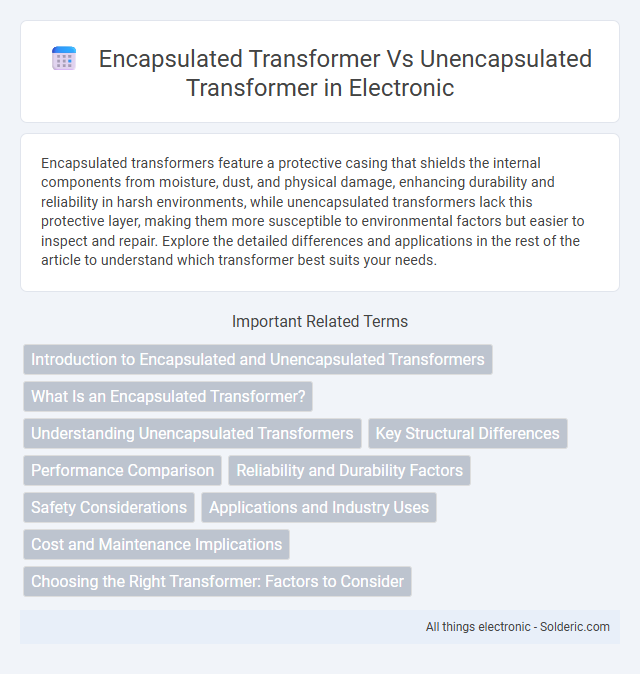Encapsulated transformers feature a protective casing that shields the internal components from moisture, dust, and physical damage, enhancing durability and reliability in harsh environments, while unencapsulated transformers lack this protective layer, making them more susceptible to environmental factors but easier to inspect and repair. Explore the detailed differences and applications in the rest of the article to understand which transformer best suits your needs.
Comparison Table
| Feature | Encapsulated Transformer | Unencapsulated Transformer |
|---|---|---|
| Protection | Enclosed in sealed casing, protects from dust, moisture, and mechanical damage | Exposed components, vulnerable to environmental factors and physical damage |
| Durability | High durability due to protective enclosure | Lower durability, sensitive to external conditions |
| Heat Dissipation | Limited, containment may require additional cooling solutions | Better heat dissipation due to open design |
| Applications | Indoor environments, sensitive equipment, harsh environments | Outdoor use and where heat dissipation is critical |
| Maintenance | Less frequent, harder access | Easy inspection and repair |
| Cost | Generally higher due to additional materials and manufacturing | Lower cost, simpler design |
Introduction to Encapsulated and Unencapsulated Transformers
Encapsulated transformers are designed with insulating materials like resin or epoxy that protect the internal components from environmental factors such as moisture, dust, and chemicals, enhancing durability and reliability in harsh conditions. Unencapsulated transformers lack this protective coating, exposing the windings and core to external elements, which may lead to increased maintenance and susceptibility to damage. Your choice between encapsulated and unencapsulated transformers depends on the application environment and required protection level.
What Is an Encapsulated Transformer?
An encapsulated transformer is a type of electrical transformer sealed within a protective casing typically filled with insulating resin or oil, which safeguards internal components from moisture, dust, and mechanical damage. This encapsulation enhances the transformer's durability, reduces maintenance needs, and improves safety by preventing electrical faults caused by environmental exposure. In contrast, unencapsulated transformers lack this protective enclosure, making them more vulnerable to external contaminants and physical damage.
Understanding Unencapsulated Transformers
Unencapsulated transformers consist of core and coil windings exposed without protective casing, making them vulnerable to environmental factors like moisture, dust, and mechanical damage. These transformers are commonly used in controlled indoor environments where cooling and accessibility are prioritized. Their design allows easier inspection and maintenance but requires careful handling to prevent contamination and ensure insulation integrity.
Key Structural Differences
Encapsulated transformers feature a sealed casing that protects internal components from moisture, dust, and contaminants, enhancing durability and suitability for harsh environments. Unencapsulated transformers lack this protective enclosure, exposing windings and core directly to external conditions, which may increase vulnerability to damage and corrosion. The encapsulation material, often epoxy resin, provides electrical insulation and mechanical support, whereas unencapsulated types rely on air or oil insulation without a rigid external shell.
Performance Comparison
Encapsulated transformers offer superior performance in harsh environments due to their sealed design, which protects internal components from moisture, dust, and contaminants, reducing the risk of failure and extending lifespan. In contrast, unencapsulated transformers may provide easier heat dissipation but are more susceptible to environmental damage, leading to potentially lower reliability and increased maintenance costs. Your choice depends on the operational conditions, with encapsulated transformers excelling in durability and consistent performance under challenging conditions.
Reliability and Durability Factors
Encapsulated transformers offer enhanced reliability and durability due to their sealed construction, which protects internal components from moisture, dust, and corrosive environments, reducing the risk of insulation failure and extending operational lifespan. Unencapsulated transformers, while easier to inspect and repair, are more vulnerable to environmental factors such as humidity, contaminants, and mechanical damage, leading to higher chances of insulation degradation and reduced durability. The encapsulation materials, typically epoxy or resin, provide superior thermal stability and mechanical strength, resulting in more consistent performance under harsh conditions compared to unencapsulated transformers.
Safety Considerations
Encapsulated transformers offer enhanced safety by enclosing the core and windings in a protective resin or casing, which prevents moisture ingress, reduces fire hazards, and minimizes exposure to electrical shock. Unencapsulated transformers lack this protective barrier, increasing risks associated with environmental damage, physical contact, and potential short circuits. Choosing an encapsulated transformer enhances your system's overall reliability and operational safety, especially in harsh or sensitive environments.
Applications and Industry Uses
Encapsulated transformers offer enhanced protection against moisture, dust, and chemicals, making them ideal for harsh industrial environments such as chemical plants, oil refineries, and outdoor installations. Unencapsulated transformers are preferred in controlled indoor settings like laboratories or manufacturing facilities, where easy access for maintenance and cooling is crucial. Your choice between these transformer types depends on specific application needs and operational conditions in industries like power distribution, automation, and robotics.
Cost and Maintenance Implications
Encapsulated transformers typically have higher initial costs due to their robust sealing and protective materials, which reduce exposure to environmental factors and lower the frequency of maintenance. Unencapsulated transformers are generally less expensive upfront but may incur higher long-term maintenance expenses because they are more susceptible to moisture, dust, and other contaminants that can degrade performance. Your choice between the two should consider the trade-off between upfront investment and ongoing maintenance requirements based on the operating environment.
Choosing the Right Transformer: Factors to Consider
Selecting the right transformer involves evaluating factors such as environmental conditions, safety requirements, and maintenance needs. Encapsulated transformers provide superior protection against moisture, dust, and contaminants, making them ideal for harsh or corrosive environments. Unencapsulated transformers offer easier access for inspection and repairs, fitting applications where controlled conditions and routine maintenance are priorities.
encapsulated transformer vs unencapsulated transformer Infographic

 solderic.com
solderic.com